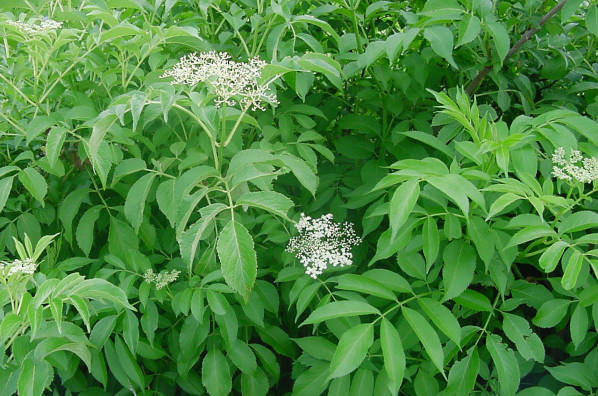The live stakes were bare sticks bundled together. We tapped them in the ground with a mallet. There they stood all winter long, an experiment in faith. The idea being that they quickly grow vast root systems, securing and stabilizing the soil around them in the process.
We weren’t able to get them as deeply into the ground as I wanted, but we did our best.
This is what they look like today:
These bushes will be wonderful for wildlife, pollinators, and us, and they will also thrive in the areas we put them. They love getting lots of water at various times and can easily tolerate drought in between.
Plant Details
Sambucus canadensis
Common Elderberry
Scientific Name: |
Sambucus canadensis
|
|---|---|
Genus: |
Sambucus
|
Species Epithet: |
canadensis
|
Common Name: |
Common Elderberry
|
Plant Type |
Shrub
|
Life Cycle |
Perennial
|
Plant Family |
Caprifoliaceae (Honeysuckle Family)
|
Native/Alien: |
NC Native
|
Size: |
6-12 ft.
|
Bloom Color(s): |
White
|
Light: |
Sun - 6 or more hours of sun per day, Part Shade - 2 to 6 hours of sun per day
|
Soil Moisture: |
Moist
|
Bloom Time: |
April, May, June, July
|
Growing Area: |
Mountains, Piedmont, Sandhills, Coastal Plain
|
Habitat Description: |
Streambanks, thickets, marshes, moist forests, disturbed areas. Common throughout NC.
|
Leaf Arrangement: |
Opposite
|
Leaf Retention: |
Deciduous
|
Leaf Type: |
Leaves veined, not needle-like or scale-like
|
Leaf Form: |
Compound
|
Life Cycle: |
Perennial
|
Wildlife Value: |
Important for Wildlife
|
Landscape Value: |
Suitable for home landscapes
|
Notes: |
Plants can be vigorous growers and may need more management to control. Attract butterflies and birds.
|
Blooming Plants
They are very attractive shrubs.

along the highway and railroad right-of-way, Black Mountain
© MB Baumeister | |


It’s amazing they took root and lived by just sticking the stalks in the ground. They should make a pretty grouping.
ReplyDeleteThey were cut in points at one end to make it easier to pound them in, and you could see the live tissue inside the stakes, but it was definitely amazing to see them leaf out this spring. We kept the bundles in a bucket of water like flowers until we put them in, as recommended. It’s a great option for areas on slopes that get random flooding due to rainfall. You can also plant them on ditch banks by putting the stakes horizontally into the bank!
ReplyDelete